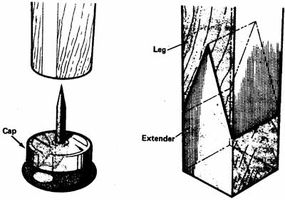How to Repair Legs and Feet on Heavy Furniture
The legs and feet of furniture pieces -- especially heavy cabinets, dressers, and bookcases -- are subjected to both weight and lateral stress when they're moved. Pushing a heavily loaded piece of furniture can cause problems even if it doesn't cause immediate breakage, and these problems are very common in old pieces. Structural breaks should be repaired.
Loose Casters
A caster is secured by a metal rod driven into a hole drilled in the bottom of the leg. When the piece of furniture is moved, stress on the caster rod can damage the wood around it, enlarging the hole and loosening the caster. If the damage isn't too bad, the casters may just be loose. If the problem has been ignored too long, the casters may fall out when the piece is lifted or the ends of the legs may be split. Both problems can be solved.
Advertisement
To tighten loose casters, use metal or plastic caster sleeve inserts, which are available in several sizes. Remove the loose caster, and tap the insert into the hole in the leg. No adhesive is needed. The sleeve should fit snugly; if it doesn't, use larger inserts. Insert the caster into the sleeve. This should solve the problem.
If the leg is split, remove all the casters on the piece. Apply glue along the split, and press the glued edges firmly together; wipe off excess glue. To reinforce the break, bind the split with several wraps of fine black steel wire. On many pieces of furniture there is a ridge or a crevice at the caster point; if you wrap the wire around the leg at this point, the repair will not be obvious. If the leg doesn't have any carving or decoration at this point, you can notch the wood all the way around with a triangular file, and then wrap the wire in the notch. Treat all legs the same way so that they match.
One Leg Shorter Than the Rest
When one leg on wooden furniture is shorter than the rest, you may be tempted to cut the other legs down to match the shorter one. Don't do it. Instead, build up the short leg to match the others. Cutting usually results in serious mismatching, besides shortening the piece and ruining its design.
If the leg is only a little too short, use a metal leg cap to build it up. These caps, made in several sizes, have from one to three prongs on a metal base. To install a cap, just hammer in the prongs. To make sure you don't split the wood, center the cap on the leg and lightly tap it to mark the prong positions. Then drill tiny holes to accept the prongs.

If a metal cap doesn't work, you may be able to add a wood extender to the leg. Cut the extender from the same wood as the piece of furniture, if possible; shape it to match. Fit the extender exactly, and then glue and nail it to the bottom of the short leg; countersink the nails. You'll probably have to refinish the entire piece to blend the extender with the rest of the wood.
If the gap is really wide, you can V-notch the leg and the extender and glue the parts together, forming an A-shaped brace. This is a very strong repair and will give the piece a real handmade look, so you don't have to match the wood exactly. Assemble the joint with glue and countersunk small nails. Drive the nails where they won't show, and fill the holes with wood filler. Even if the holes are visible, it won't look bad.
Doors on wooden furniture also frequently need to be repaired. In the next section, we'll tell you how to do it.
